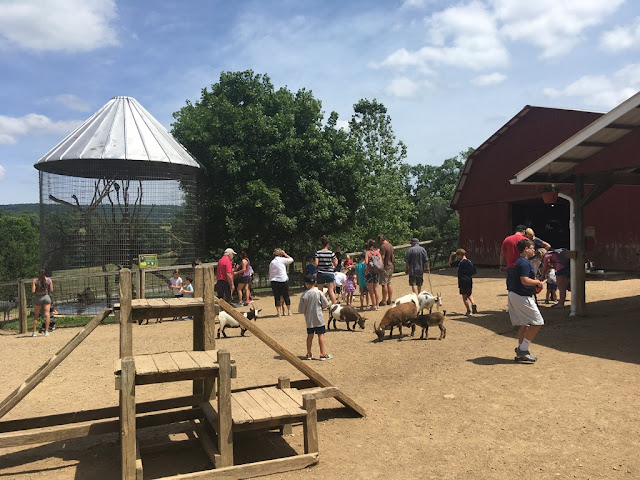Continuing from yesterday's start to our tour of Lake Tobias Wildlife Park, we continue to explore the walk-through portion of the park.
As you might infer from the name, Lake Tobias Wildlife Park is built around a lake. Most of the animal exhibits that you access on foot are grouped on one end of the lake; the exceptions are the giraffes and associated exhibits that I mentioned in yesterday's post. There isn't really any special grouping or organization to these habitats - geographic, taxonomic, thematic - so I'll be discussing them in general.

The best habitats in this area were the hoofstock habitats, a non-connected series of yards that hold species that, for one reason or another, might not work out as well in the Safari Tours. These include plains zebras and ostriches in one yard, gemsbok in another, and chital (axis deer, or Asian spotted deer) in another. These are all species that I've encountered before in safari park settings, so I'm not sure why Lake Tobias has decided to keep them separate, but I didn't think it was a poor decision (zebras especially have a reputation for causing trouble in large mixed-species habitats).

The three large carnivore habitats - lion, tiger, and American black bear - struck me as odd. All three struck me as over-engineered, completely enclosed under dome-like roofs or metal grating. Such exhibits are considerably more expensive to build that open-roof habitats and, due to structural reasons, tend to be smaller. The habitats did strike me as a bit on the small side - especially the lion one - though not the worst I've seen. I'm just very curious as to what the decision process was for that. Was there perhaps some local ordinance that the park could only have big cats if they were roofed in? Was there a bad experience in the past? I don't know. Assuming that there is no such policy, I would have recommended building (better, larger, cheaper) open-topped habitats for these species elsewhere in the park - there seems to be plenty of room. The emptied exhibits could be repurposed for other cat species, such as leopard or puma, which should be roofed-over, or primates.

Speaking of which...
If Lake Tobias has a weakness, it's definitely the primate exhibits. With the exception of the olive baboons (adjacent to the lions in a similar exhibit), some tamarins in the Reptile House, and black-and-white ruffed lemurs just outside, they were universally awful. Small. Bare. Too exposed to the public. There was a series of monkey corn-crib cages set into a petting yard of goats and sheep and I cringed looking at them. At another habitat, an angry white-handed gibbon was reaching out a visitors, who reached back (thankfully there was enough of a secondary barrier in place), obviously unaware that the ape would rip their faces off. If I were in a consulting role at Lake Tobias, new primate housing would be my number one priority.

There were a smattering of small bird exhibits around the park, as well as prairie dogs, collared peccary (in a habitat that, to my concern, it was possible to reach into - not sure how USDA let that one slide), kangaroos, and an attractive yard of capybara fronting a small lake. A small museum serves as an educational center about the history of the park, also holding a 500-gallon freshwater aquarium and a toucan exhibit. The last substantial habitat was the Reptile House which, I must say, was a lot more impressive than what I usually find at safari parks. Usually you get cheap plywood cages with a few Burmese pythons and other pet store species. This was actually a pretty attractive building with a decent collection, all wrapped around a central education presentation area that was in turn backed up against pools of American alligator and alligator snapping turtle. The back wall of the building was a glass window into an aviary for various macaws, as well as Sarus cranes. I was not the least bit surprised to find a staffer standing in the corner of the building alternating between letting visitors interact with a juvenile alligator and a ball python.

I used to be much more of a stickler about only visiting AZA-accredited institutions, so that I could be sure about the quality of the animal care. I've found myself bending a little in recent years. Part of it is because I've gotten to know a few excellent non-AZA facilities. Part of it is also, I admit, a search for novelty. AZA animal collections have become increasingly homogenous over the years, as some species are phased out in order to build more sustainable populations of other species. What that translates to is lots of collections resemble one another. Going to non-AZA zoos does offer some new animals; olive baboons, for example, are a species that is very abundant in the wild (I've had to chase them out of my campsites in Africa) but which you no longer see in AZA zoos.

Taken as a whole, Lake Tobias wasn't a bad facility. Like many private zoos there is a strong focus on animal interaction - I was actually surprised not to see a budgie or lorikeet feeding aviary or a kangaroo walk-through, those being two staples of many such facilities. I wouldn't say "no" to visiting again - I don't think I'd go too far out of my way to go back, but if I was in the area, I'd probably stop by out of curiosity. There are definitely parts of the facility which should be either upgraded or replaced entirely, the primates being my strongest criticism. That's something that's true of many facilities, accredited and otherwise. I hope that, before making any further expansions, the park takes the opportunity to upgrade the facilities for some of the animals that it currently has.



























